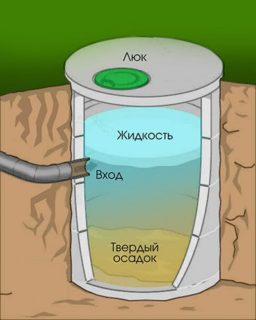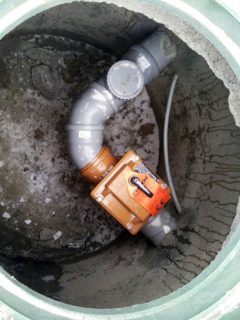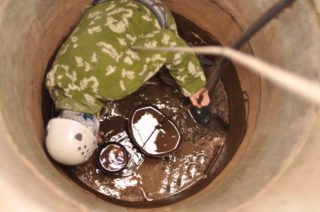Some owners of private houses, having difficulty arranging a septic tank, limit themselves to digging a hole and draining its bottom. Water goes into the ground, and all substances settle to the bottom. When the pit stops working properly, a new one is dug. There are several reasons why the drive is full.
The main causes of the problem
- The porous part of the soil is clogged with fat.
- A thick organic muddy layer was formed, which settled to the bottom and did not allow water to pass through.
- Leaves or other debris have fallen into the pit.
- The groundwater level has increased.
- Wastewater sources (additional plumbing fixtures) have been added.
- An incorrect calculation of the volume of sewage or natural water flow has been made.
- In winter, the ground freezes and does not absorb liquid.
Methods to Remediate Bad Churn
According to the law of communicating vessels, the levels of homogeneous liquids (if you count from the nearest point on the surface) should be the same. If we take the cesspool for one vessel, and the hygroscopic layer of soil around it for the second, then the ability of the second “vessel” to absorb liquid should be taken into account. That is, the rate of filling the well must be synchronous with the rate of absorption. To do this, it is enough to reduce the volume of incoming water (reduce the stream when washing dishes, washing, and so on).
In addition to this method of preventing overflow of the cesspool, there are several more important and effective ones:
- Provide all taps with grease traps.
- Equip a septic tank (you can dig a new hole next to the old one, connecting them to get communicating vessels).
- Clean it yourself with a bucket or fecal sucker. To do this, you should invite an assistant, stock up on overalls, protect your eyes, respiratory tract and skin from poisonous vapors and substances. Order a suction pump, provided the pit depth is no more than 3 meters.
- Pump out the water, soften and reduce the sludge volume with the help of bacteria. Clean the bottom and walls of the pit with a brush.
- Remove grease from sewer pipes. Rinse again with hot water.
- Replace the filter by placing a 40 cm layer of gravel or rubble and sand on the bottom.
- To destroy the organic crust at the bottom of the pit, a biological product ("Vodogray" and "Alligator") is used, which purify wastewater. But as a result, the water will drop only by 10-50 cm. If you pump out much more, the pressure of the liquid in the pit will drop, and it will again be filled with water from the ground (according to the law of communicating vessels). In addition, expensive bacteria that have been launched into the pit and have not yet begun work will disappear.
In order for such drugs to be used as much as possible, they need to create conditions:
- The thickness of the water covering the waste should not exceed 5 cm (otherwise the process will slow down a lot.) But then the balance of the liquid columns in the pit and the hygroscopic soil is disturbed.
- Positive temperature (otherwise the bacteria are inactive).
- Refuse while cleaning the pit from the "killers" of bacteria: chlorine, manganese, antibacterial substances that are in detergents.
- Prepare a copper wire that transmits 2 kW, a small hook, a 20 cm long metal pin, put on rubber boots and gloves.
- Remove bystanders, animals and containers with liquids from the area of action.
- Drive a pin into the center of the hole.
- Strip the end of the wire and connect it to the rod in the hole.
- Use a hook to connect the other end of the wire to electricity.
- Defrost for two days.
They also use blowtorches or make fires, but this is long and unpleasant. If the plastic sewer pipes are also frozen, it is necessary to call specialists who will quickly and without risk defrost the entire system along with the pit.
Preventive measures to avoid the problem
- The use of chemicals for the rapid breakdown of solid accumulations. When choosing them, one should take into account their impact on the environment. The cheapest, but also the most dangerous, is formaldehyde. The drug with nitrate is expensive, but the product of its action is applicable as a fertilizer. In addition, this drug neutralizes odors.
- Use (once a month) of bacteriological preparations in the warm season.
- Periodic and timely waste pumping. For this, an automatic pump can be installed that does not require the presence of a person.
- Regular (every 6-8 weeks) flushing of the entire system with water under pressure.
- Warming and continuous use of the pit in winter for regular heating.
- The main condition for the functioning of the cesspool is the correct calculation when laying the entire sewer system and carrying out a geological examination to establish the depth of the water.
- Water drainage to the filtration field. It is carried out both at the initial stage of the device and during operation. To do this, next to the pit, they dig the soil one and a half meters down, make a pillow of agrofibre and crushed stone, and lay a perforated pipe on it to drain the liquid. It is covered with rubble, then with agrofibre.
Conclusion
Even such a simple sewerage device as a cesspool requires correct calculation in its arrangement and good care. To reduce the cost of service equipment, two thirds of the contents of the pit should fit into the sump. This should be taken into account when laying the last sewer link. Pumping is less expensive than buying chemicals, but they are not associated with dirt or bad odors. In addition, the service life of the pit is increased.













Under the USSR, they did it simply: they poured a jar of mercury into a pit. Mercury found its way out in the ground, and water left behind it….